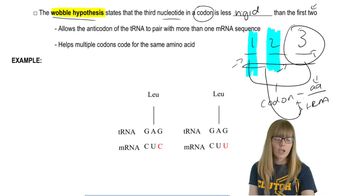Here are the essential concepts you must grasp in order to answer the question correctly.
One-Gene:One-Enzyme Hypothesis
The one-gene:one-enzyme hypothesis, proposed by George Beadle and Edward Tatum, suggests that each gene encodes a single enzyme that catalyzes a specific biochemical reaction. This concept was foundational in linking genes to metabolic processes, but it oversimplifies the relationship between genes and proteins, as many genes produce multiple products through alternative splicing or post-translational modifications.
Recommended video:
Translation:Wobble Hypothesis
Gene Function Beyond Enzymes
Modern genetics recognizes that not all genes encode enzymes; many genes produce structural proteins, regulatory proteins, or non-coding RNAs that play critical roles in cellular function. This broader understanding highlights that gene products can have diverse functions beyond mere enzymatic activity, complicating the one-gene:one-enzyme model.
Recommended video:
Gene Interactions and Pathways
Gene interactions and metabolic pathways illustrate that multiple genes can influence a single trait or function, leading to a network of interactions rather than a linear relationship. This complexity means that the effects of one gene can depend on the presence and activity of others, challenging the simplistic view of one gene corresponding to one enzyme.
Recommended video:
Interacting Genes Overview




